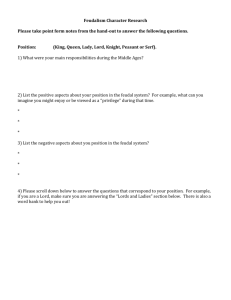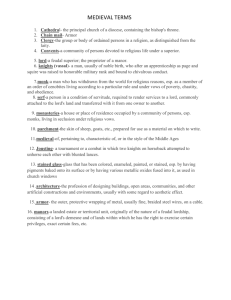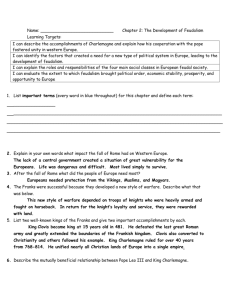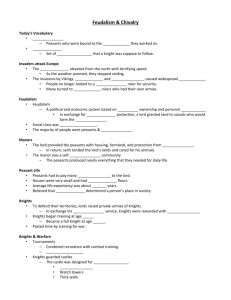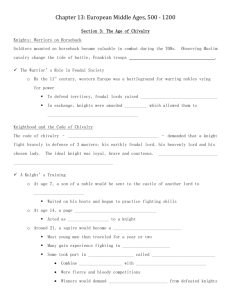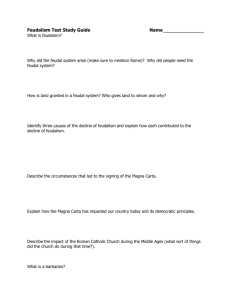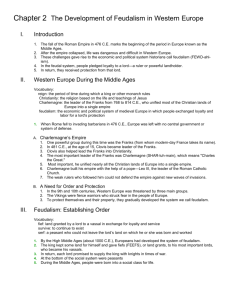Expert Text: Feudalism in Western Europe
advertisement
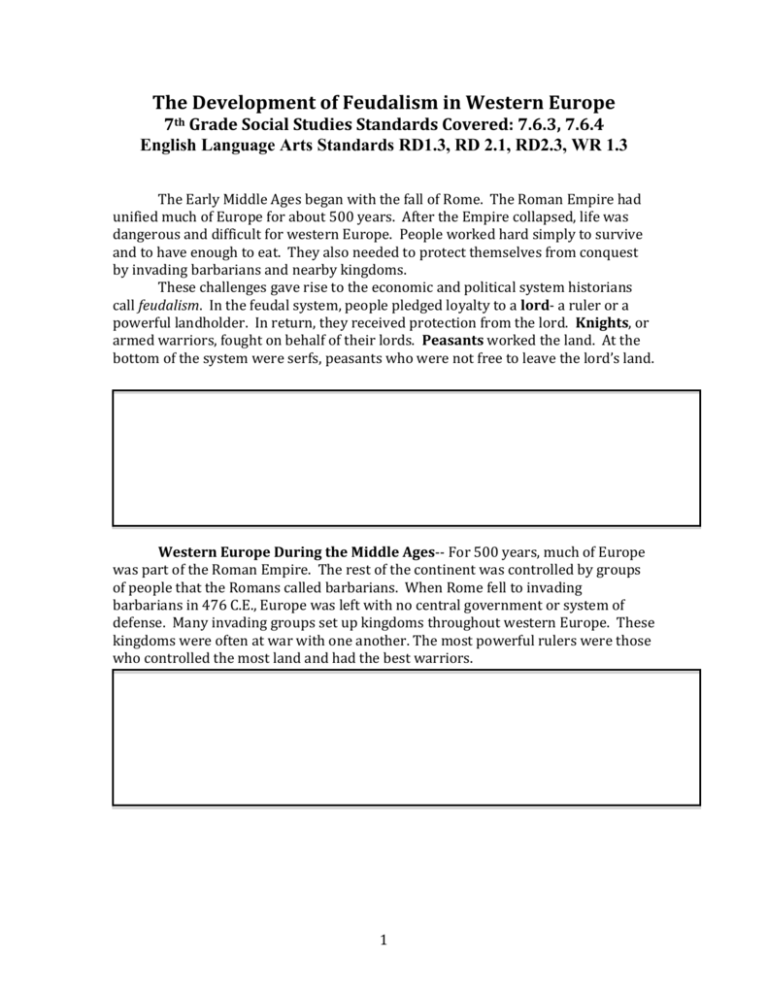
The Development of Feudalism in Western Europe 7th Grade Social Studies Standards Covered: 7.6.3, 7.6.4 English Language Arts Standards RD1.3, RD 2.1, RD2.3, WR 1.3 The Early Middle Ages began with the fall of Rome. The Roman Empire had unified much of Europe for about 500 years. After the Empire collapsed, life was dangerous and difficult for western Europe. People worked hard simply to survive and to have enough to eat. They also needed to protect themselves from conquest by invading barbarians and nearby kingdoms. These challenges gave rise to the economic and political system historians call feudalism. In the feudal system, people pledged loyalty to a lord- a ruler or a powerful landholder. In return, they received protection from the lord. Knights, or armed warriors, fought on behalf of their lords. Peasants worked the land. At the bottom of the system were serfs, peasants who were not free to leave the lord’s land. Western Europe During the Middle Ages-- For 500 years, much of Europe was part of the Roman Empire. The rest of the continent was controlled by groups of people that the Romans called barbarians. When Rome fell to invading barbarians in 476 C.E., Europe was left with no central government or system of defense. Many invading groups set up kingdoms throughout western Europe. These kingdoms were often at war with one another. The most powerful rulers were those who controlled the most land and had the best warriors. 1 Charlemagne’s Empire-- One powerful group during this time was the Franks (from whom modern-day France takes its name). The Franks were successful because they had developed a new style of warfare. It depended on troops or knights, heavily armed warriors who fought on horseback. To get and hold power, a ruler needed the services and loyalty of many knights. In return for their loyalty and service, the ruler rewarded knights with land and privileges. The most important leader of the Franks was Charlemagne (Charles the Great). This impressive king ruled for over 40 years, from 768 to 814. Charlemagne built his empire with the help of a pope—Leo III, the leader of the Catholic Church in Rome. For Charlemagne, the blessing of the church sent the message “God is on my side.” For his part, Leo needed the support of someone with an army. In return for Charlemagne’s help, the pope crowned him Holy Roman emperor in 800 C.E. In the 9th and 10th centuries, western Europe was threatened by three main groups. Muslims, or followers of the religion of Islam, advanced from the Near East and northern Africa into what is now Spain. Magyars, a central Asian people, pressed in from the east. And Vikings swept down from present-day Norway and Denmark. 2 Monarchs During Feudal Times-- Most medieval monarchs believed in the divine right of kings, the idea that God had given them the right to rule. In reality the power of monarchs varied greatly. Some had to work hard to maintain control of their kingdoms. Few had enough wealth to keep their own army. They had to rely on their vassals, especially nobles, to provide enough knights and soldiers. In some places, especially during the Early Middle Ages, great lords grew very powerful and governed their fiefs as independent states. In these cases, the monarch was little more than a figurehead, a symbolic ruler who had little real power. Lords and Ladies During Feudal Times-- Like monarchs, lords and ladies were members of the nobility, the highest -ranking class in medieval society. Most lived on manors. Some lords had one manor, while others had several. Those who had more than one manor usually lived in one for a few months and then traveled with their families to the next. It was the lord’s responsibility to manage and defend his land and the people who worked it. The lord appointed officials to make sure villagers carried out their duties, which included farming the lord’s land and paying rent in the form of crops. Lords also acted as judges in manor courts and had the power to fine and punish those who broke the law. Some lords held posts in the king’s government. In times of war, lord fought for their own higher-ranking lords or at least supplied them with a well-trained fighting force. 3 Knights During Feudal Times-- The path to becoming a knight involved many years of training. A boy started as a page, or servant. At the age of seven, he left home and went to live at the castle of a lord, who was often a relative. Nearly all wealthy lords had several pages living in their castle. A page learned how to ride a horse and received religious instruction from the local priest of friar. After about seven years as a page, a young boy became a squire. During this part of this training, he spent most of this time with the knight who was his lord. He polished the knight’s armor, sword, shield, and lance. He helped care for his horse. He even waited on him at mealtime, carrying water for hand washing, carving meat, and filling his cup with it was empty. Most importantly, squires trained to become warriors. They learned how to fight with a sword and lance, a kind of spear that measured up to 15 feet long. They also learned how to use a battle-ax and a mace (a club with a heavy metal head). They practiced by fighting in make-believe battles. But squires also went into real battles. A squire was expected to help dress his lording armor, follow him into battles, and look after him if he was wounded. In his early 20s, if he was deserving, a squire became a knight. Becoming a knight could be a complex religious event. A squire often spent the night before his knighting in prayer. The next morning, he bathed and put on a white tunic, or long shirt, to show his purity. During the ceremony, he knelt before his lord and said his vows. The lord drew his sword, touched the knight-to-be lightly on each shoulder with the flat side of the blade, and knighted him. Sometimes, if a squire did particularly well in battle, he was knighted on the spot. The Responsibilities and Daily Life of Knights-- Being a knight was more than a profession. It was a way of life. Knights lived by a strong code of behavior called chivalry. (Chivalry comes from the French word cheval, meaning “horse.”) Knights were expected to be loyal to their church and their lord, to be just and fair, and to protect the helpless. They performed acts of gallantry, or respect paid to women. From their acts, we get the modern idea of chivalry as traditional forms of courtesy and kindness toward women. 4 Peasants During Feudal Times-- Most people during the Middle Ages were peasants. They were not part of the feudal relationship of vassal and lord, but they supported the entire feudal structure by working the land. Their labor freed lords and knights to spend their time preparing for war or fighting. The daily life of peasants revolved around work. Most peasants raised crops and tended livestock (farm animals). But every manor also had carpenters, shoemakers, smiths (metalworkers), and other skilled workers. Peasant women worked on the fields when they were needed. They also cared for their children and their homes. In addition to the work they performed, serfs owed the lord numerous taxes. There was a yearly payment called “head money,” which was a fixed amount per person. The lord could also demand a tax known as tallage whenever he needed money. When a woman married, she, her father, or her husband had to pay a fee called a merchet. Serfs were also required to grind their grain at the lord’s mill (the only mill in the village). The miller kept portions of the grain for the lord and for himself. Lords could keep any amount they wanted. Serfs found this practice so hateful that some of them hid small hand mills in their houses. 5 The Development of Feudalism in Western Europe Key vocabulary Feudalism- an economic and political system of medieval Europe after the fall of Rome Barbarian- a person belonging to a tribe or group that is considered uncivilized Pope- the bishop of Rome and supreme leader of the Roman Catholic Church Monarch- a ruler such as a king or queen Fief -land granted by a lord to a vassal in exchange for loyalty and service Manor- a large estate, including farmland and villages held by a lord Divine right of kings- the belief that God gives monarchs the right to rule Noble- a person of high rank by birth or title Duke- the highest type of European noble ranking just below a prince. Moat- a deep, wide ditch, often filled with water Hierarchy- a system of organizing people into ranks, with those of higher rank having more power and privileges Vassal 6
